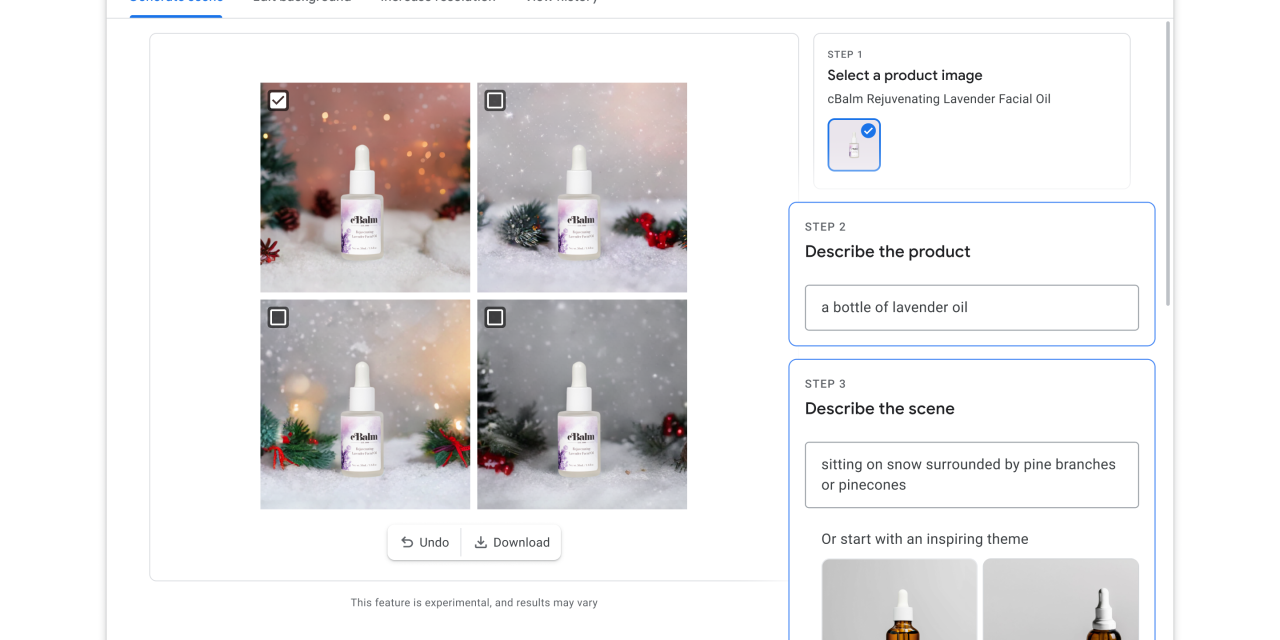How generative AI is powering new advertising tools from platforms like Google

Every major ad platform is releasing AI tools to help streamline ad campaign creation and help brands create more variations of creative assets.
This week, Google rolled out its AI-powered Product Studio, a set of generative AI product imagery tools, to all U.S. users of Google’s Merchant Center Next as well as the Google Shopify app, just in time for brands to create assets for their holiday campaigns. Google first announced Product Studio back in May, which is designed to help merchants create different variations of product images and make small tweaks to a photo like improving the image resolution using generative AI within minutes. Brands start by uploading a core product image and then receive a text prompt to generate different background images from four choices. They can use these images on their Google listings or on their own e-commerce sites or social media campaigns.
Separately, last week, tech giant Amazon introduced a new generative AI ad tool in beta that generates lifestyle images based on a core product image. The tool can, for example, take an image of a toaster that appears on a kitchen counter and create an image with waffles popping out of the toaster, or next to other kitchen appliances.
Put together, tech companies are pitching these tools as a way for brands to generate higher conversion rates by creating more appealing imagery for ads, which in turn would fuel higher ad revenue growth for these platforms. “Brands will see an effect in terms of growing the revenue base that the advertising channels can capture with these tools,” Andrew Frank, vice president of research at Gartner, told Modern Retail.
This comes as these technology juggernauts vie for advertising dollars. During its third-quarter earnings last month, Amazon reported a 12% year-over-year increase in advertising revenue to $12 billion. While Alphabet’s ad revenue grew 9% to $59.6 billion in this most recent third quarter.
As Frank sees it, these tech companies have an interest in removing barriers for small- to mid-sized businesses to participate in the advertising ecosystem. Specifically, they want to ramp up more productivity in terms of creation of content he added. “One of those barriers has always been creative production costs. By eliminating that they are certainly inspiring the long tail market to participate more in these kinds of campaigns and hence, they’re growing the size of the market,” said Frank.
The platforms see an opportunity to make it easier for brands to produce better imagery. Matt Madrigal, vice president and general manager for merchant shopping at Google, said Google’s generative AI platform, which is integrated into the Merchant Center creation flow, gives both merchants and agencies the ability to create new scenes, new backgrounds from existing assets. “We wanted to make this technology accessible to merchants of all sizes and really lower the barrier to entry to create these images,” said Madrigal. Google’s Merchant Center Next gives brands control over how their products appear on Google. Merchant Center is the interface where online retailers can upload their product data and information related to their e-commerce store including images etc.
Other use cases of Google’s Product Studio include removal of certain backgrounds based on a core product image, and it also has the ability to increase and improve image resolution for existing assets, said Madrigal.
Beyond the ability to create these new assets, Madrigal said Product Studio is very powerful because it’s integrated into the workflow. “You select the image, and it’s automatically updated, for example, in your feed that powers your product listing ads, as well as your free listings,” he said.
Google ran a beta test with brands like DoppleTree, Big Spoon Roasters and Glow Boost that tested Product Studio this past May. Madrigal said these brands were able to generate these images and launch them on their own e-commerce site or through different marketing campaigns in a matter of minutes, as opposed to days and weeks.
There are, however, some potential pitfalls. Frank pointed out that while adopting these AI tools, brands should be aware that it’s easy for their rivals to use them to create knockoff images. “It’s not only about creating more content for your own brand but making sure that the content that’s being created by their competitors and detractors isn’t having a negative effect on your brand,” he said.
Ultimately, Frank said, as more and more brands have access to these tools it could force them to think more strategically about how they’re differentiating from all of the other brands in their categories to avoid clutter.
“We can’t just have all the brands look the same, because they use the same tools and they have the same strategy, then eventually everything becomes a price competition,” Frank said. “They’re going to have to think more strategically about differentiation and brand messaging, as opposed to simply showcasing their products.”

